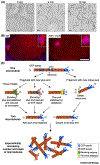Cutting, Amplifying, and Aligning Microtubules with Severing Enzymes
- PMID: 33183955
- PMCID: PMC7749064
- DOI: 10.1016/j.tcb.2020.10.004
Cutting, Amplifying, and Aligning Microtubules with Severing Enzymes
Abstract
Microtubule-severing enzymes - katanin, spastin, fidgetin - are related AAA-ATPases that cut microtubules into shorter filaments. These proteins, also called severases, are involved in a wide range of cellular processes including cell division, neuronal development, and tissue morphogenesis. Paradoxically, severases can amplify the microtubule cytoskeleton and not just destroy it. Recent work on spastin and katanin has partially resolved this paradox by showing that these enzymes are strong promoters of microtubule growth. Here, we review recent structural and biophysical advances in understanding the molecular mechanisms of severing and growth promotion that provide insight into how severing enzymes shape microtubule networks.
Keywords: microtubule dynamics; microtubule nucleation; severase.
Copyright © 2020 The Author(s). Published by Elsevier Ltd.. All rights reserved.
Figures






References
Publication types
MeSH terms
Substances
Grants and funding
LinkOut - more resources
Full Text Sources
Other Literature Sources

